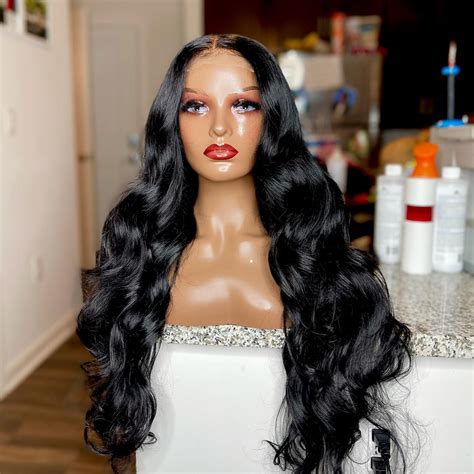Lace front wigs have become increasingly popular in recent years, offering a natural-looking and versatile hair solution. Among the various lace front wig densities, light density wigs stand out for their airy, breathable feel and effortless styling. In this comprehensive guide, we delve into the world of light density lace front wigs, exploring their benefits, drawbacks, ideal wearers, and essential maintenance tips.

Benefits of Light Density Lace Front Wigs
-
Breathable and Lightweight: Light density wigs feature fewer hair strands per square inch, resulting in a breathable feel that minimizes scalp sweating and discomfort. Weighing less than denser wigs, they provide all-day comfort without causing strain or tension on the hairline.
-
Natural Appearance: The decreased hair density mimics the natural density of human hair, creating a realistic and seamless blend with your own hair. This is especially beneficial for those seeking a natural-looking hairpiece.
-
Versatile Styling Options: Light density wigs offer ample versatility for styling. You can easily create voluminous curls, sleek bobs, or trendy braids without weighing down the wig. The reduced hair density allows for more movement and flexibility in styling.
-
Easy Maintenance: With fewer hair strands, light density wigs require less brushing and maintenance compared to denser wigs. They are less prone to tangling and matting, saving you time and effort.
Drawbacks of Light Density Lace Front Wigs
-
Less Coverage: Due to the lower hair density, light density wigs may not provide as much coverage as denser wigs. This can be a concern for individuals with significant hair loss or those seeking maximum coverage.
-
Possible Thinness: If the hair density is too low, the wig may appear thin or see-through. It’s important to choose a light density wig with a hair density that balances naturalness with adequate coverage.
Ideal Wearers of Light Density Lace Front Wigs
Light density lace front wigs are ideally suited for:
-
Those with Fine or Thin Hair: Individuals with naturally fine or thinning hair can benefit from the natural-looking density of light density wigs. The reduced hair density complements their own hair texture, creating a seamless transition.
-
First-Time Wig Wearers: For beginners, light density wigs offer a comfortable and easy-to-manage introduction to the world of lace front wigs. Their breathability and low maintenance make them a suitable option for those new to wig wearing.
-
Individuals with Sensitive Scalps: The breathable nature of light density wigs reduces scalp irritation and discomfort, making them a comfortable choice for those with sensitive skin.
Essential Maintenance Tips for Light Density Lace Front Wigs
-
Gentle Brushing: Use a wide-tooth comb or a brush specifically designed for wigs to avoid damaging delicate strands. Brush the wig gently to remove tangles, working from the ends towards the roots.
-
Avoid Over-Washing: Wash your light density wig less frequently than you would your own hair. Excessive washing can strip away natural oils and cause dryness. Use a gentle shampoo and conditioner designed for wigs.
-
Air Dry: Allow your wig to air dry naturally. Avoid using heat styling tools, as they can weaken and damage the hair fibers.
-
Store Properly: When not in use, store your light density wig on a wig stand or hang it in a cool, dry place. This helps prevent tangling and maintains the wig’s shape.
Common Mistakes to Avoid
-
Choosing Incorrect Hair Density: Selecting a light density wig with insufficient hair density can result in a thin or see-through appearance. Conversely, choosing a wig with too high a density can weigh the wig down and cause discomfort.
-
Overusing Styling Products: Excessive use of styling products, such as hairspray, can accumulate on the wig and make it look greasy or stiff. Use products sparingly and focus on the areas that need it most.
-
Neglecting Lace Maintenance: The lace that forms the front hairline of the wig needs regular attention to prevent discoloration and fraying. Clean and moisturize the lace to maintain its integrity.
FAQs
1. How long do light density lace front wigs last?
With proper care and maintenance, light density lace front wigs can last anywhere from 6 to 12 months.
2. Can I dye a light density lace front wig?
Yes, you can dye a light density lace front wig, but it’s recommended to use a semi-permanent or demi-permanent dye to avoid damaging the hair fibers.
3. How do I customize a light density lace front wig?
You can customize a light density lace front wig by cutting the lace to fit your hairline, bleaching and toning the knots to blend with your skin tone, and styling the wig to your desired look.
4. Where can I find a reputable light density lace front wig vendor?
Look for vendors that use high-quality materials, offer a wide selection of hair densities, and provide excellent customer service. Read reviews and compare prices from different vendors before making a purchase.
5. How do I properly care for the lace on a light density lace front wig?
Clean the lace regularly with a gentle cleanser and apply a lace sealant to protect it from damage. Avoid using harsh chemicals or scrubbing the lace excessively.
6. Can I sleep in a light density lace front wig?
It’s not recommended to sleep in a light density lace front wig, as it can cause tangling, matting, and damage to the wig. Remove the wig before going to bed and store it properly.
7. How do I achieve a natural-looking hairline with a light density lace front wig?
Use a thin layer of lace adhesive to secure the wig to your hairline. Trim the excess lace close to the hairline and use concealer to blend the edges.
8. Can I use heat styling tools on a light density lace front wig?
Use heat styling tools sparingly and on low heat settings to avoid damaging the hair fibers. Always apply a heat protectant spray before using heat styling tools.
